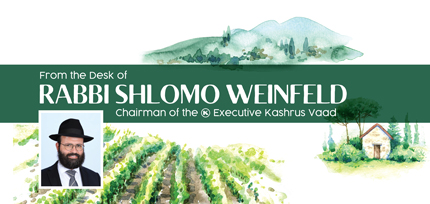This coming year (5782) is a shmitta year. The Torah commands us to work and cultivate our fields for six years and observe the seventh year as a year of rest, Torah study and spiritual transcendence, as it is written: “You may sow your field for six years, and for six years you may prune your vineyard, and gather in its produce. But in the seventh year, the land shall have a complete rest, a Sabbath to Hashem; you shall not sow your field, nor shall you prune your vineyard.”1
The mitzvah of agricultural shmitta actually has two parts: refraining from working the fields AND the sanctified status of the produce that grows during the shmitta year, which affects the sale and purchase of such produce. Although the mitzvah to observe the year of the shmitta applies only within the biblical borders of the Eretz Yisroel, where the land is sanctified, even those who live outside of Eretz Yisroel should be aware of the laws of the shmitta year due to the sanctified status of the crops grown during a shmitta year (kedushas shvi’is).
There are four categories of crops during a shmitta year:
Yevul Chu”l (Foreign Crops): These are crops grown outside of the biblical borders of Eretz Yisroel. They do not have kedushas shvi’is and can be sold and purchased. Such produce can be certified by the OK.
Yevul Nochri: These are crops grown within the biblical borders of Eretz Yisroel on land that is owned by non-Jews. A non-Jew is not obligated to observe a shmitta year. Some halachic authorities hold that any crops grown in biblical Eretz Yisroel during a shmitta year have kedushas shvi’is, even if owned by a non-Jew. Most poskim disagree, so the OK clearly labels the produce as such for those who prefer to be stringent and satisfy all opinions.
Heter Mechira – Heter Mechira is a ritual sale that allows a Jewish farmer to sell his fields to a non-Jew for the shmitta year. One issue with heter mechira is that the sale is not recorded in government records, so the majority of poskim do not recognize or accept heter mechira and consider such produce to have kedushas shvi’is. Another issue would be if the land sold under heter mechira is tended by Jewish workers. The Chief Rabbinate of Israel is stringent and permits heter mechira ONLY when all work in the fields is performed by a non-Jew. The OK does not permit the use of heter mechira produce in OK certified products or give certification on produce grown under heter mechira.
Otzar Beis Din – The Beis Din acts as an agent to distribute the hefker shmitta crop and sell it at cost price just to cover the operating, harvesting and transportation expenses. The crop has kedushas shvi’is and cannot be sent outside of the biblical borders of Eretz Yisroel.2 The OK does not permit the use of Otzar Beis Din because OK certified products are often exported out of Eretz Yisroel.
So how does a farmer who observes the laws of shmitta in the most mehudar way (without relying on Heter Mechira or Otzar Beis Din) earn a livelihood? The Torah promises: “I will command My blessing for you in the sixth year, and it will yield produce for three years.”3 It certainly takes a high level of emunah for a farmer to fully observe shmitta.
In truth, we all can observe the labor aspect of shmitta from a spiritual perspective, even outside of Eretz Yisroel. The shmitta year is a “time out” from the preoccupations of the physical, commercial world. While most of us cannot take a full-year sabbatical from our work, the shmitta year is a time to increase in our emunah through Torah study and spiritual pursuits.
The Talmud (Yoma 35b) mentions Rabbi Eliezer ben Charsom as an example of someone who, despite his status and intense schedule, invested much time in Torah studies. After a person passes on to the next world, he will be asked why he did not set aside time for Torah study every day. He might answer that he had many assets and responsibilities to take care of and no time left to study Torah. The heavenly angels will say to him: “Were you richer than Rabbi Eliezer ben Charsom who owned a huge shipping company and real estate companies that included entire cities, but nevertheless spent most of his time studying the Torah?”
We were fortunate to have our own such example in Rabbi Don Yoel Levy OB”M. He began his day in the early hours of the morning, dedicating himself to the study of Torah and Chassidus, answering halachic questions, and preparing for davening and his shiurim. Later in the day, after Mincha, Rabbi Levy gave a Gemara shiur at the office and devoted time after Ma’ariv to study Halacha and Rambam. Rabbi Levy kept his arduous schedule of shiurim and learning even during his extended trips to the Far East, replete with many kashrus inspections, and his usual heavy workload of reviewing kashrus reports and the enormous responsibility of heading an international kashrus agency.
May it be G-d’s will that we continue to walk in Rabbi Levy’s ways, emulating his strict observance of time and investment in Torah study out of pure Yiras Shomayim, and upholding the highest standards of kashrus in a pleasant manner and with goodwill. May we make good use of the days of the shmitta year and merit the fulfilment of our destiny with the immediate Final Redemption.
1 Vayikra 25:3-4.
2 Mishnah Shvi’is 6:5.
3 Vayikra 25:21.
Rabbi Weinfeld is a member of the OK Kosher Vaad HaKashrus.


 EN
EN  ZH
ZH  KR
KR  BR
BR  ES
ES  IN
IN  IL
IL 




